
I have been on a buckwheat binge recently. I have published two e-books that use 100% buckwheat flour and I could easily write more. Buckwheat is such a convenient and versatile gluten free flour. This is because, unlike other individual gluten free flours, it has elasticity. This means you can easily use buckwheat alone to produce things like, say noodles. With that mind, today’s recipe is for gluten free soba noodles.
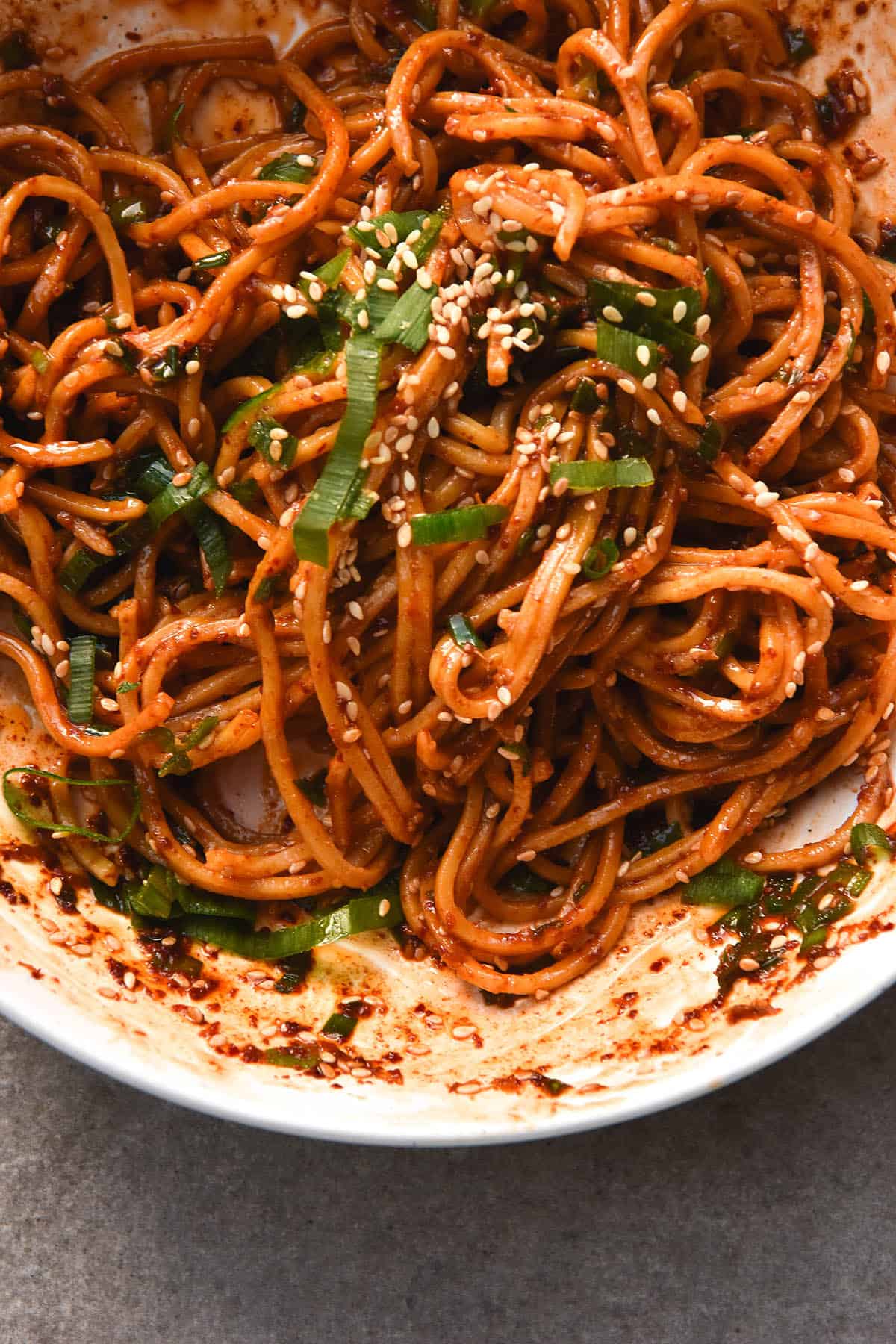
Gluten free soba noodles
These noodles could not be simpler to make. They use buckwheat flour, xanthan gum, salt and water. That’s it! As such, they are vegan, gluten free, low FODMAP and nut free. Because the noodles use xanthan gum, they hold up really well to being tossed in sauce or in a salad. The noodles also freeze really well, so you can make a big batch for speedy dinners (they cook straight from frozen).
Can I make these soba noodles without xanthan gum?
This specific recipe needs xanthan gum to succeed. However, I have a xanthan gum free recipe for buckwheat soba noodles in my buckwheat e-book. Those noodles are xanthan gum free, egg free, vegan, nut free – the works.
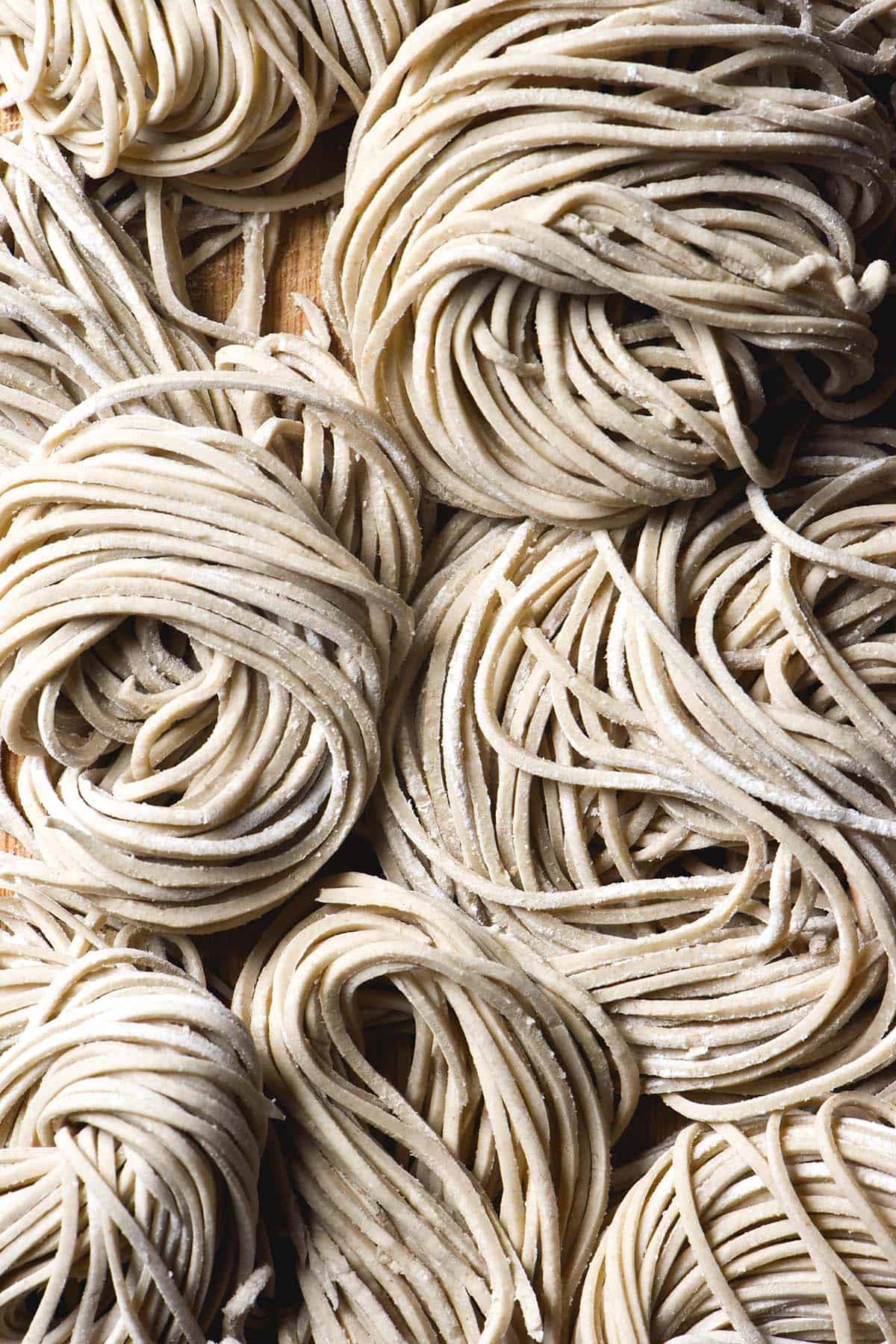
Do I need a pasta machine to make these 100% buckwheat soba noodles?
It is highly recommended. Noodles swell during cooking, and big chunks of thick buckwheat noodle don’t have the same appeal. I don’t know whether you can roll these out by hand because I value my time too much to attempt it lol. But seriously, you can generally find unwanted pasta machines at the op shop and even the bad ones do the job well enough.
I have my sister’s old Jamie Oliver brand pasta machine and it’s not very good but it works for the simple tasks I need it for. If you intend to make gluten free noodles (or pasta) regularly it is worth the meagre investment.
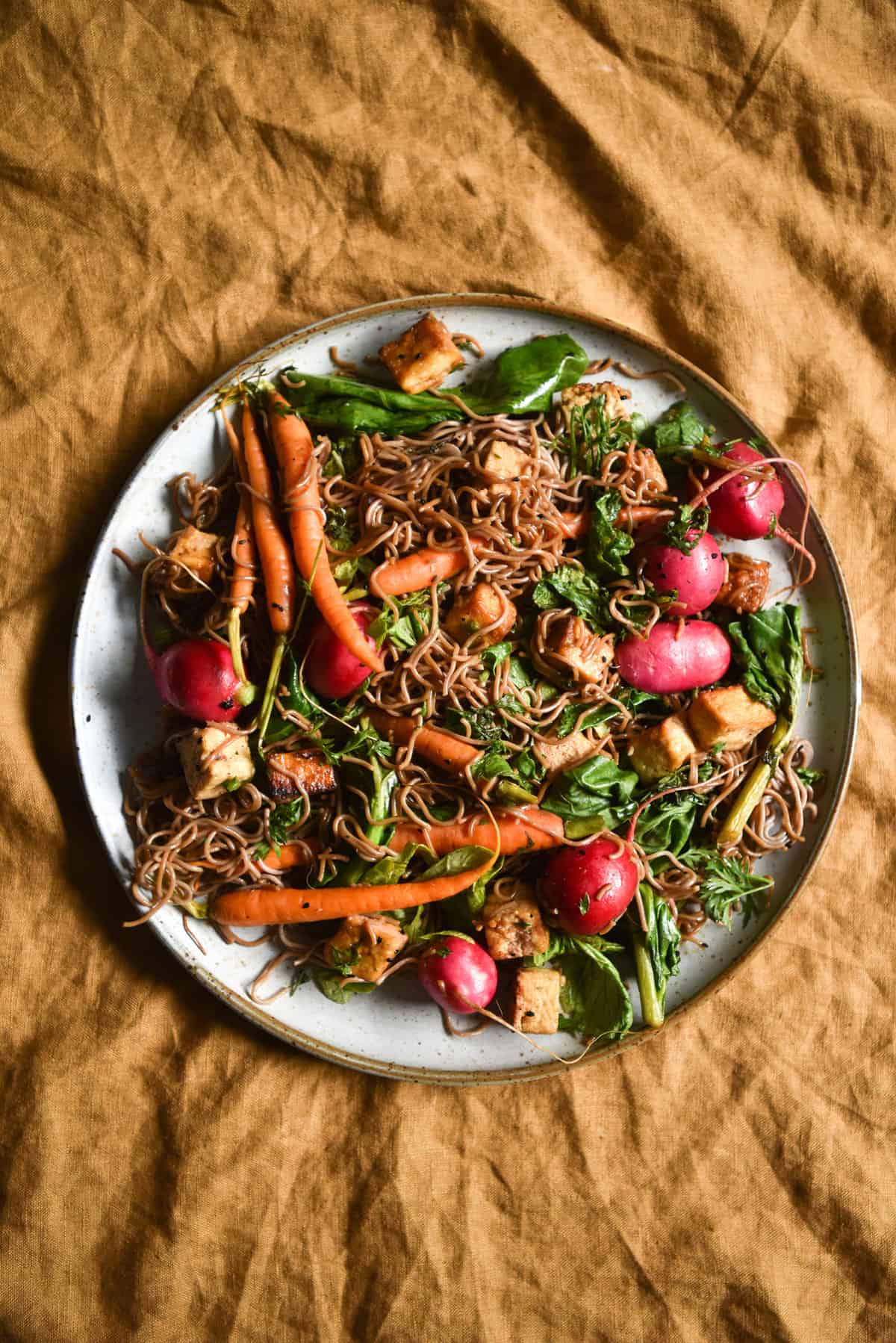
Ingredient notes for your gluten free soba noodles
As we have discussed, xanthan gum is necessary for this recipe. There is no substitute – I have not tried guar gum or psyllium husk powder. If you want a xanthan gum free buckwheat noodle recipe, see my buckwheat e-book.
I have only tested light buckwheat flour because that is all I have access to here in Australia. I cannot say whether dark buckwheat flour would work. From my understanding, dark buckwheat flour is unhulled whereas light buckwheat flour is hulled. I don’t know whether this has an impact on how much liquid the flour needs or even whether the FODMAP content changes.
Fine salt is required to ensure the noodles are easy to put through the pasta machine. Sea salt flakes aren’t suitable. With that said, you don’t have to add salt if you don’t want to. Although the noodles themselves will be bland, they will still work if you need to minimise your sodium. Plus, noodles are all about the sauce you serve them with.
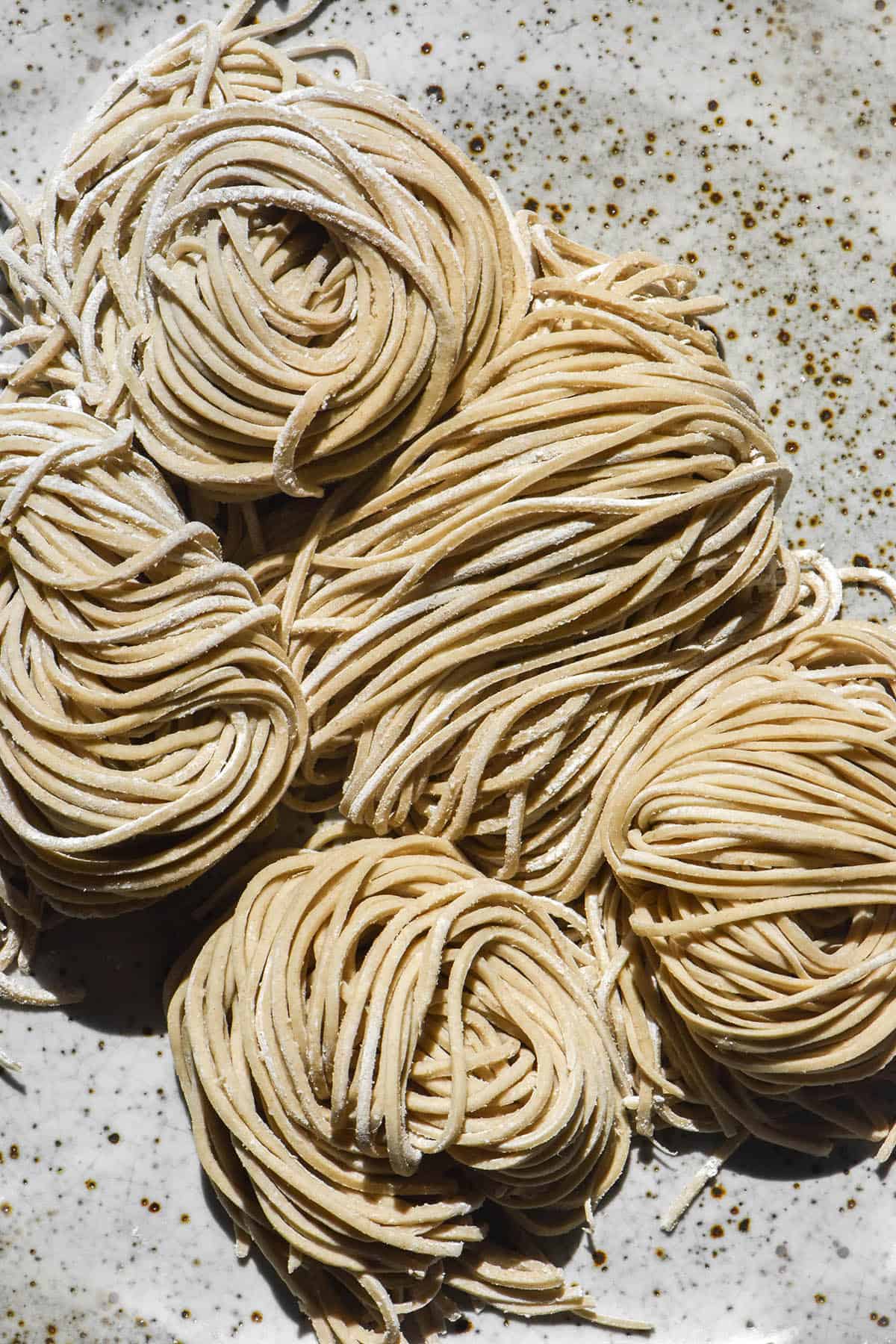
Tips for making your gluten free soba noodles
A dry dough (drier than you think could possibly work) will make your life so much easier as you roll it out. Gradually working the dough on the bench will enable you to determine the minimum amount of liquid required for your dough. It will be different for every batch you make, as every bag of buckwheat flour will have a slightly different absorbency.
It is always better for the dough to start off too dry as opposed to too wet. You can add more liquid to achieve the desired consistency, but you can’t take it away.
The ideal dough is smooth and forms a ball without being wet. There should be no dry crusty spots, but you should be able to pick it up with absolute ease and without it leaving dough on your hands.
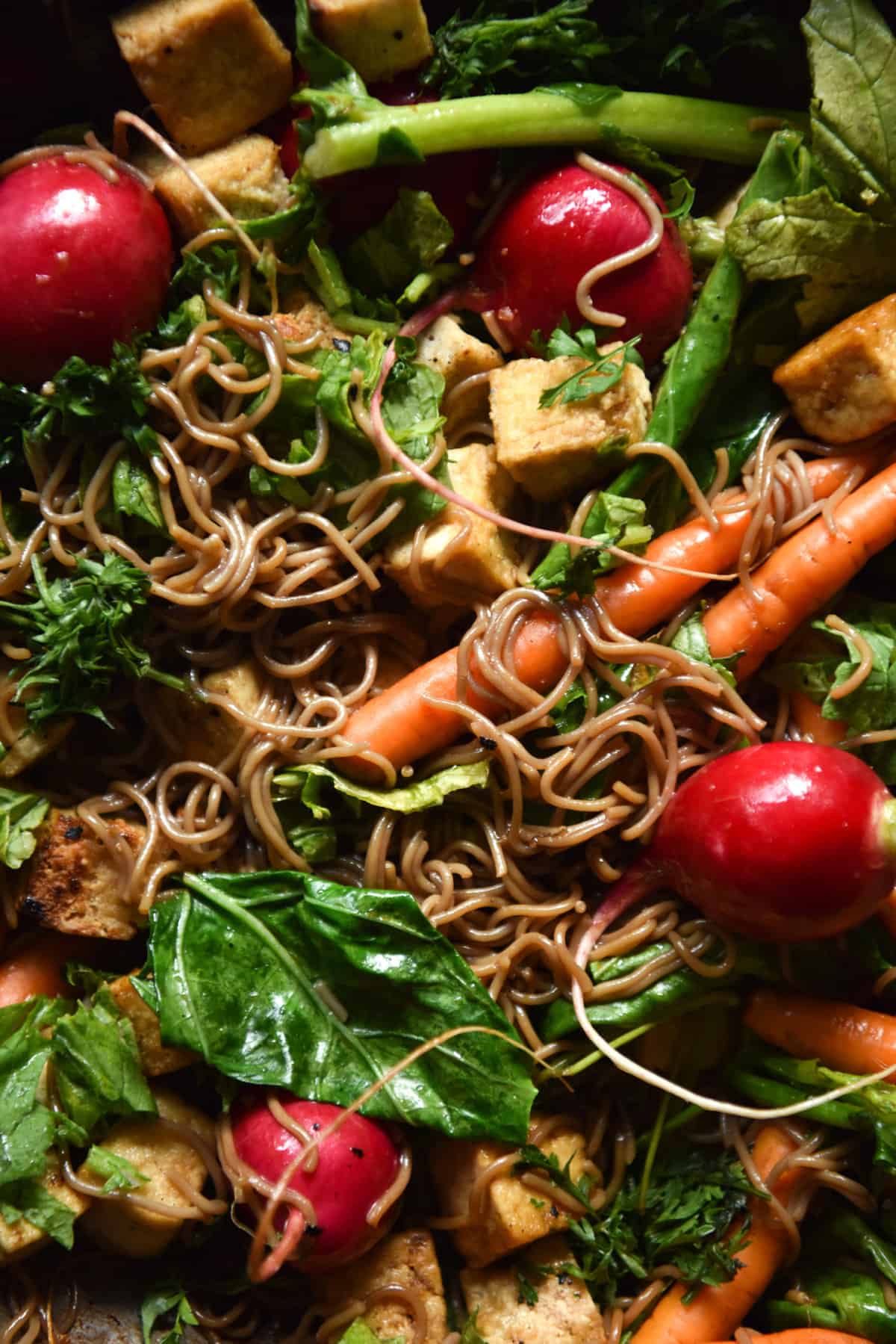
Tips for rolling out your soba noodles
Tapioca flour/starch is always my choice for rolling out dough. Its easy to find, inexpensive and very soft without any grittiness. I find glutinous rice flour too gritty and potato starch too solid (if that makes sense) for rolling out too. Personally, I think buckwheat flour for rolling out is too gritty and leads to a textured dough which is harder to put through the machine.
Make sure the bench is liberally floured. This will ensure the dough doesn’t get stuck as you roll it out on the bench. This is particularly important if you have added too much liquid to your dough. You’ll need a considerable amount of tapioca flour to course correct to a drier dough.
The dough rolls out nicely, so I like to roll it to a width that will get through the pasta machine’s finer settings. I think working and working gluten free dough through a machine to be thin enough to cut is cumbersome and ends up being more work. Half the time it tears and you have to redo it, anyway.
I like to trim the scrappy edges off each long rolled out piece of dough. I then use water to moisten the scrappy bits and restore them to their former glory.
This is a stiff dough and requires a bit of elbow grease to roll. Making it slightly more moist (150g water) and using plenty of tapioca flour makes it a bit easier to roll out, but it is still a firm dough.
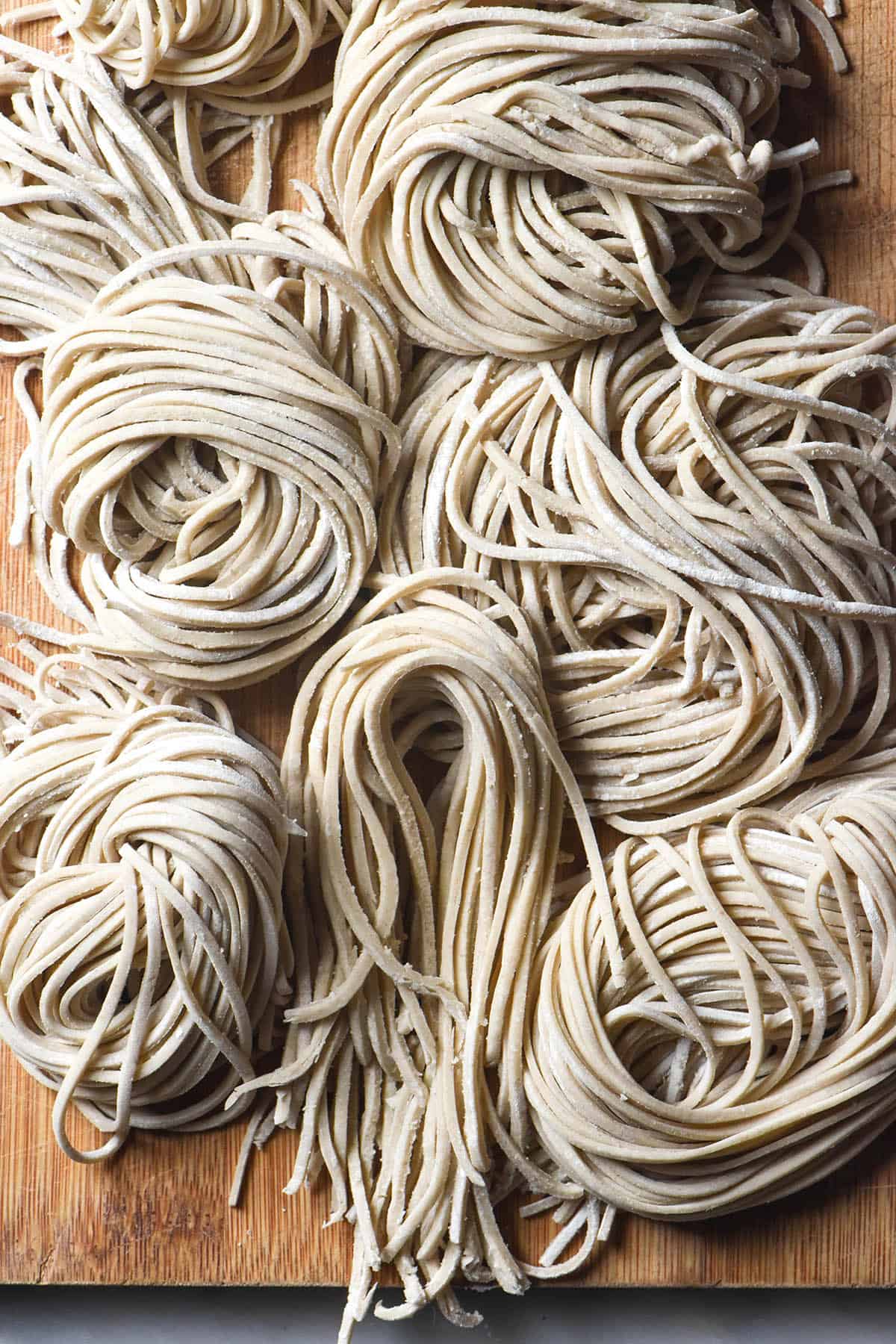
Tips for cooking your gluten free soba noodles
These noodles only require a very short cooking time. I find with all gluten free noodles it is best to cook them on a low boil as opposed to a vigorous boil, as it prevents the noodles from breaking.
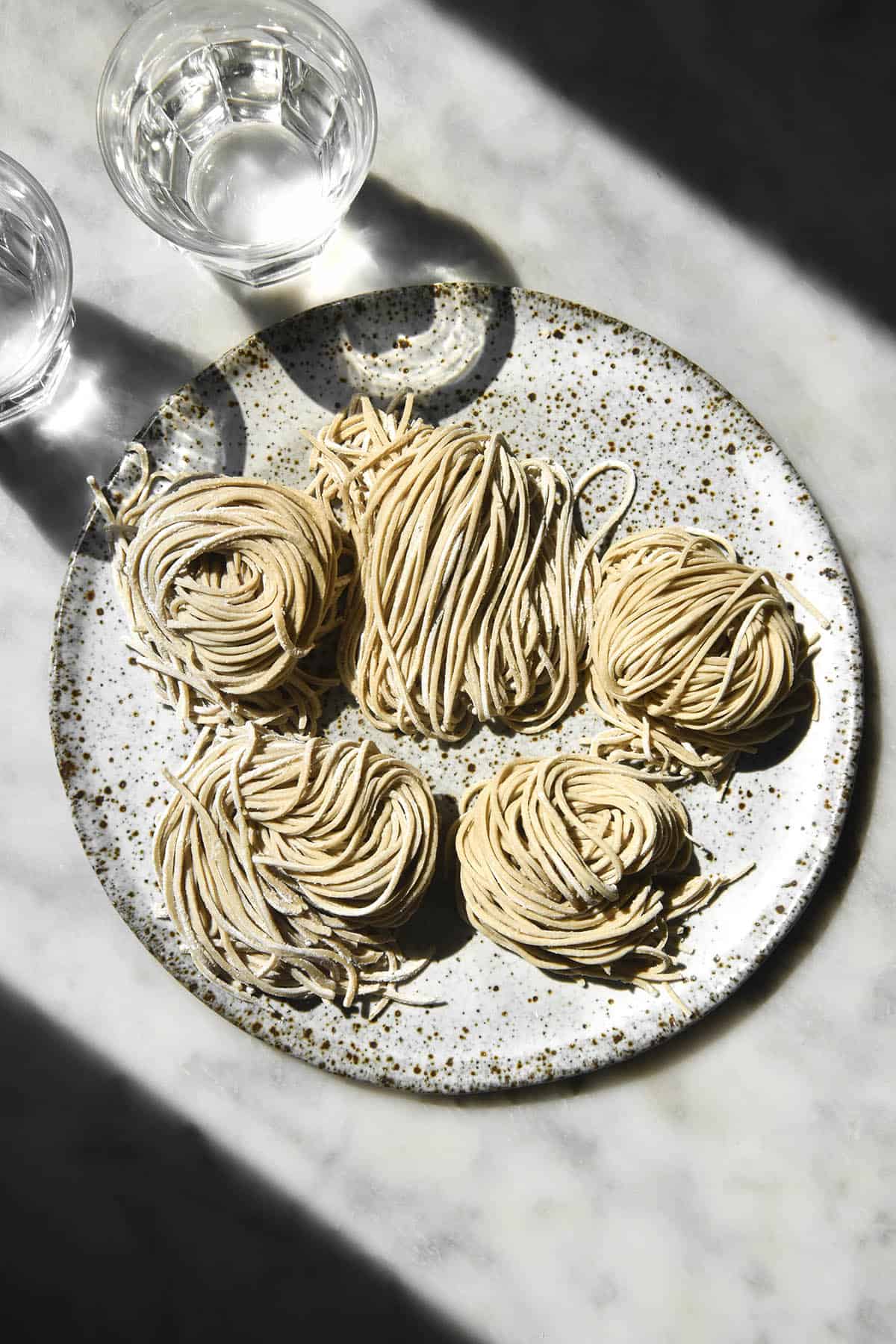
More gluten free noodle based recipes
- This simple low FODMAP chilli oil noodle dish (which you can use these buckwheat soba for)
- Low FODMAP vegetarian lasagne using homemade buckwheat lasagne sheets – a recipe in my second buckwheat flour e-book
- Low FODMAP vegetarian or vegan Pad Thai
- Sweet and sticky buckwheat noodles (vegan, low FODMAP and a perfect use for these noodles)
- A xanthan gum free buckwheat soba recipe that uses naught but buckwheat flour, water and salt (from my first buckwheat flour e-book)

Gluten free soba noodles
Equipment
- Pasta machine with fine pasta cutter
Ingredients
- 300 g buckwheat flour
- 3-5 g fine salt
- 3 g (1 teaspoon) xanthan gum
- 100-150 g water
- Tapioca flour for rolling
Instructions
- Whisk together the buckwheat flour, salt and xanthan gum in a medium bowl. Pour over the water, then use a fork to combine as much as you can. The mixture will likely look dry and crumbly (this is the right texture!)
- Tip the mixture out onto a dry, clean work surface. Begin to knead it into a dough. It doesn’t look like it, but this will turn into a stiff but smooth ball of dough. It takes a couple of minutes of kneading, so don’t be tempted to add more water yet. Wetter dough is harder to roll out later, so we want the dough to be as smooth and hydrated yet dry as possible.
- If the dough truly won’t come together, add a teaspoon of extra water at a time until it does.
- Divide the dough into 3-4 pieces, then use the tapioca flour to roll the first ball out into a long, really thin rectangle of dough. I find the noodles are less likely to snap if they’re shorter, so I recommend slicing the rectangle in half if it’s getting too long. I also like to trim the edges of my dough rectangles to remove the scraggly uneven sides. You can moisten them lightly and add them to the next ball of dough.
- Feed the thin rectangle through the spaghetti cutter of your pasta machine, then swirl each bundle softly into a group of noodles.
- Repeat with the remaining dough. You can cook the noodles on the spot, place them in an airtight container in the fridge or freeze them and cook them from frozen.
- To cook the noodles, bring a large pot of well salted water to a simmer. A rolling boil will break up the noodles, so keep it to a simmer.
- Cook the noodles for 2 or so minutes or until they are puffed and cooked through.
- Very gently strain the noodles.
- For best results, drizzle the drained noodles with a scant amount of oil (I use toasted sesame) and very gently toss. Add dressings of your choice and serve.
- Leftovers keep well in an airtight container in the fridge.
Notes
- The dough should not have any dry spots after you have kneaded it into a ball. You should be able to rather up all the buckwheat flour on the bench as you knead the dough.
- I find it easiest to get the dough to pasta roller thickness myself rather than using the machine. The sheets of dough can break, so the less times through the machine, the better.
- The dough is easy to roll out, but requires some elbow grease to get thin enough for rolling.
- Make sure you have plenty of tapioca flour on hand for rolling out. Each batch of dough is different, and tapioca flour will help you course correct if your dough is too moist. If you want a xanthan gum free recipe, see the version in my buckwheat flour e-book.

Hi Georgia – can you clarify about the water. Do you start by puring over 100g to start with (step 1?) The range is 100-150 which seems pretty wide even with variability. thank you!
Hi Allison, the point of the water range is to ensure people go by their dough rather than a specific number. I’ve written about this in the tips for your dough section.
I find every batch takes a slightly different amount of water. Also, slightly (only slightly) wetter doughs are easier to roll out (a note in the tips for rolling out your noodles section) so the variation accounts for both preference and the absorption of the flour.
Sometimes I see people rely too much on a specific number in a recipe rather than what their dough needs. The only requirement is that is a stiff but smooth dough – the liquid number is less important than that.
Hope that helps!